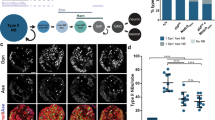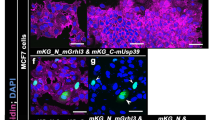Abstract
Understanding how epithelial polarity is established and regulated during tissue morphogenesis is a major issue. Here, we identify a regulatory mechanism important for mesoderm invagination, germ-band extension and transepithelial migration in the Drosophila melanogaster embryo. This mechanism involves the inhibition of the conserved E3 ubiquitin ligase Neuralized by proteins of the Bearded family. First, Bearded mutant embryos exhibited a loss of epithelial polarity associated with an early loss of the apical domain. Bearded regulated epithelial polarity by antagonizing neuralized. Second, repression of Bearded gene expression by Snail was required for the Snail-dependent disassembly of adherens junctions in the mesoderm. Third, neuralized was strictly required to promote the downregulation of the apical domain in the midgut epithelium and to facilitate the transepithelial migration of primordial germ cells across this epithelium. This function of Neuralized was independent of its known role in Notch signalling. Thus, Neuralized has two distinct functions in epithelial cell polarity and Notch signalling.
This is a preview of subscription content, access via your institution
Access options
Subscribe to this journal
Receive 12 print issues and online access
$209.00 per year
only $17.42 per issue
Buy this article
- Purchase on Springer Link
- Instant access to full article PDF
Prices may be subject to local taxes which are calculated during checkout








Similar content being viewed by others
References
St Johnston, D. & Ahringer, J. Cell polarity in eggs and epithelia: parallels and diversity. Cell 141, 757–774 (2010).
Nance, J. & Zallen, J. A. Elaborating polarity: PAR proteins and the cytoskeleton. Development 138, 799–809 (2011).
Harris, T. J. & Tepass, U. Adherens junctions: from molecules to morphogenesis. Nat. Rev. Mol. Cell Biol. 11, 502–514 (2010).
Laprise, P. & Tepass, U. Novel insights into epithelial polarity proteins in Drosophila. Trends Cell Biol. 21, 401–408 (2011).
Mavrakis, M., Rikhy, R. & Lippincott-Schwartz, J. Plasma membrane polarity and compartmentalization are established before cellularization in the fly embryo. Dev. Cell 16, 93–104 (2009).
Lecuit, T. Junctions and vesicular trafficking during Drosophila cellularization. J. Cell Sci. 117, 3427–3433 (2004).
Harris, T. J. & Peifer, M. The positioning and segregation of apical cues during epithelial polarity establishment in Drosophila. J. Cell Biol. 170, 813–823 (2005).
McGill, M. A., McKinley, R. F. & Harris, T. J. Independent cadherin-catenin and Bazooka clusters interact to assemble adherens junctions. J. Cell Biol. 185, 787–796 (2009).
Dawes-Hoang, R. E. et al. Folded gastrulation, cell shape change and the control of myosin localization. Development 132, 4165–4178 (2005).
Leptin, M. & Grunewald, B. Cell shape changes during gastrulation in Drosophila. Development 110, 73–84 (1990).
Sweeton, D., Parks, S., Costa, M. & Wieschaus, E. Gastrulation in Drosophila: the formation of the ventral furrow and posterior midgut invaginations. Development 112, 775–789 (1991).
Brodland, G. W. et al. Video force microscopy reveals the mechanics of ventral furrow invagination in Drosophila. Proc. Natl Acad. Sci. USA 107, 22111–22116 (2010).
Kolsch, V., Seher, T., Fernandez-Ballester, G. J., Serrano, L. & Leptin, M. Control of Drosophila gastrulation by apical localization of adherens junctions and RhoGEF2. Science 315, 384–386 (2007).
Nikolaidou, K. K. & Barrett, K. A Rho GTPase signaling pathway is used reiteratively in epithelial folding and potentially selects the outcome of Rho activation. Curr. Biol. 14, 1822–1826 (2004).
Martin, A. C., Kaschube, M. & Wieschaus, E. F. Pulsed contractions of an actin-myosin network drive apical constriction. Nature 457, 495–499 (2009).
Martin, A. C., Gelbart, M., Fernandez-Gonzalez, R., Kaschube, M. & Wieschaus, E. F. Integration of contractile forces during tissue invagination. J. Cell Biol. 188, 735–749 (2010).
Chanet, S., Vodovar, N., Mayau, V. & Schweisguth, F. Genome engineering-based analysis of Bearded family genes reveals both functional redundancy and a nonessential function in lateral inhibition in Drosophila. Genetics 182, 1101–1108 (2009).
Leviten, M. W., Lai, E. C. & Posakony, J. W. The Drosophila gene Bearded encodes a novel small protein and shares 3′ UTR sequence motifs with multiple Enhancer of split complex genes. Development 124, 4039–4051 (1997).
Lai, E. C., Bodner, R. & Posakony, J. W. The enhancer of split complex of Drosophila includes four Notch-regulated members of the bearded gene family. Development 127, 3441–3455 (2000).
Fontana, J. R. & Posakony, J. W. Both inhibition and activation of Notch signaling rely on a conserved Neuralized-binding motif in Bearded proteins and the Notch ligand Delta. Dev. Biol. 333, 373–385 (2009).
Bardin, A. J. & Schweisguth, F. Bearded family members inhibit Neuralized-mediated endocytosis and signaling activity of Delta in Drosophila. Dev. Cell 10, 245–255 (2006).
Le Borgne, R., Bardin, A. & Schweisguth, F. The roles of receptor and ligand endocytosis in regulating Notch signaling. Development 132, 1751–1762 (2005).
Weinmaster, G. & Fischer, J. A. Notch ligand ubiquitylation: what is it good for? Dev. Cell 21, 134–144 (2011).
De Renzis, S., Yu, J., Zinzen, R. & Wieschaus, E. Dorsal–ventral pattern of Delta trafficking is established by a Snail-Tom-Neuralized pathway. Dev. Cell 10, 257–264 (2006).
Lai, E. C., Bodner, R., Kavaler, J., Freschi, G. & Posakony, J. W. Antagonism of notch signaling activity by members of a novel protein family encoded by the bearded and enhancer of split gene complexes. Development 127, 291–306 (2000).
Grawe, F., Wodarz, A., Lee, B., Knust, E. & Skaer, H. The Drosophila genes crumbs and stardust are involved in the biogenesis of adherens junctions. Development 122, 951–959 (1996).
Tepass, U. Crumbs, a component of the apical membrane, is required for zonula adherens formation in primary epithelia of Drosophila. Dev. Biol. 177, 217–225 (1996).
Ni, J-Q. et al. A genome-scale shRNA resource for transgenic RNAi in Drosophila. Nat. Meth. 8, 405–407 (2011).
Morel, V. & Schweisguth, F. Repression by suppressor of hairless and activation by Notch are required to define a single row of single-minded expressing cells in the Drosophila embryo. Genes Dev. 14, 377–388 (2000).
Morel, V., Le Borgne, R. & Schweisguth, F. Snail is required for Delta endocytosis and Notch-dependent activation of single-minded expression. Dev. Genes Evol. 213, 65–72 (2003).
Lopez-Schier, H. & Johnston, D. S. Delta signaling from the germ line controls the proliferation and differentiation of the somatic follicle cells during Drosophila oogenesis. Dev. Cell 15, 1393–1405 (2001).
Campos-Ortega, J. A. & Hartenstein, V. The Embryonic Development of Drosophila melanogaster (Springer, 1997).
Campbell, K., Whissell, G., Franch-Marro, X., Batlle, E. & Casanova, J. Specific GATA factors act as conserved inducers of an endodermal-EMT. Dev. Cell 21, 1051–1061 (2011).
Kunwar, P. S., Siekhaus, D. E. & Lehmann, R. In vivo migration: a germ cell perspective. Annu. Rev. Cell Dev. Biol. 22, 237–265 (2006).
Kunwar, P. S. et al. Tre1 GPCR initiates germ cell transepithelial migration by regulating Drosophila melanogaster E-cadherin. J. Cell Biol. 183, 157–168 (2008).
Lee, J. Y. & Harland, R. M. Endocytosis is required for efficient apical constriction during Xenopus gastrulation. Curr. Biol. 20, 253–258 (2010).
Harris, K. P. & Tepass, U. Cdc42 and Par proteins stabilize dynamic adherens junctions in the Drosophila neuroectoderm through regulation of apical endocytosis. J. Cell Biol. 183, 1129–1143 (2008).
Roeth, J. F., Sawyer, J. K., Wilner, D. A. & Peifer, M. Rab11 helps maintain apical crumbs and adherens junctions in the Drosophila embryonic ectoderm. PLoS ONE 4, e7634 (2009).
Ishiuchi, T. & Takeichi, M. Willin and Par3 cooperatively regulate epithelial apical constriction through aPKC-mediated ROCK phosphorylation. Nat. Cell Biol. 13, 860–866 (2011).
Samarin, S. N., Ivanov, A. I., Flatau, G., Parkos, C. A. & Nusrat, A. Rho/Rho-associated kinase-II signaling mediates disassembly of epithelial apical junctions. Mol. Biol. Cell 18, 3429–3439 (2007).
Campbell, K., Knust, E. & Skaer, H. Crumbs stabilises epithelial polarity during tissue remodelling. J. Cell Sci. 122, 2604–2612 (2009).
Morais-De-Sa, E., Mirouse, V. & Johnston, D. S. aPKC phosphorylation of bazooka defines the apical/lateral border in Drosophila epithelial cells. Cell 141, 509–523 (2010).
Choi, E. Y., Santoso, S. & Chavakis, T. Mechanisms of neutrophil transendothelial migration. Front Biosci. 14, 1596–1605 (2009).
Jaglarz, M. K. & Howard, K. R. Primordial germ cell migration in Drosophila melanogaster is controlled by somatic tissue. Development 120, 83–89 (1994).
Jaglarz, M. K. & Howard, K. R. The active migration of Drosophila primordial germ cells. Development 121, 3495–3503 (1995).
Benhra, N., Vignaux, F., Dussert, A., Schweisguth, F. & Le Borgne, R. Neuralized promotes basal to apical transcytosis of delta in epithelial cells. Mol. Biol. Cell 21, 2078–2086 (2010).
Koo, B. K. et al. An obligatory role of mind bomb-1 in notch signaling of Mammalian development. PLoS ONE 2, e1221 (2007).
Wirtz-Peitz, F., Nishimura, T. & Knoblich, J. A. Linking cell cycle to asymmetric division: Aurora-A phosphorylates the Par complex to regulate Numb localization. Cell 135, 161–173 (2008).
Acknowledgements
We thank M. Biggin (Lawrence Berkeley National Laboratory, Berkeley, USA), P. Bryant (University of California Irvine, Irvine, California, USA), K. Choi (Baylor College of Medicine, Houston, Texas, USA), Y-N. Jan (University of California San Francisco, San Francisco, California, USA), D. Kiehart (Duke University, Durham, North Carolina, USA), J. Knoblich (Institute of Molecular Biotechnology, Austria, Vienna), P. Lasko (McGill University, Montreal, Quebec, Canada), M. Leptin (University of Koln, Koln, Germany), A. Martinez-Arias (University of Cambridge, Cambridge, UK), N. Perrimon (Harvard University, Boston, USA), A. Preiss (University of Hohenheim, Hohenheim, Germany), M. Rand, (University of Vermont, Burlington, Vermont, USA), J. Skeath (Washington University, Saint Louis, Missouri, USA), U. Tepass (University of Toronto, Toronto, Canada), E. Wieschaus (Princeton University, Princeton, New Jersey, USA) and A. Wodarz (University of Góttingen, Góttingen, Germany) the Bloomington Drosophila Stock Center, the Developmental Studies Hybridoma Bank and Flybase for flies, antibodies and other resources. We thank S. Guadagnini for the scanning electron microscopy. We are very grateful to L. Couturier for her help in the analysis of midgut polarity. We thank V. Mayau for technical help and A. Bardin, T. Lecuit, M. Leptin and all laboratory members for discussion and critical reading. This work was financially supported by the CNRS, Institut Pasteur, ANR (08-BLAN-0235) and FRM (DEQ20100318284). S.C. received fellowships from the MENRT and the ARC.
Author information
Authors and Affiliations
Contributions
S.C. performed all of the experiments. F.S. and S.C. analysed the data and wrote the paper.
Corresponding author
Ethics declarations
Competing interests
The authors declare no competing financial interests.
Supplementary information
Supplementary Information
Supplementary Information (PDF 1239 kb)
Rights and permissions
About this article
Cite this article
Chanet, S., Schweisguth, F. Regulation of epithelial polarity by the E3 ubiquitin ligase Neuralized and the Bearded inhibitors in Drosophila. Nat Cell Biol 14, 467–476 (2012). https://doi.org/10.1038/ncb2481
Received:
Accepted:
Published:
Issue Date:
DOI: https://doi.org/10.1038/ncb2481
This article is cited by
-
Notch-mediated inhibition of neurogenesis is required for zebrafish spinal cord morphogenesis
Scientific Reports (2019)
-
From morphogen to morphogenesis and back
Nature (2017)
-
Spatial regulation of contractility by Neuralized and Bearded during furrow invagination in Drosophila
Nature Communications (2017)
-
Embryo-scale tissue mechanics during Drosophila gastrulation movements
Nature Communications (2015)



